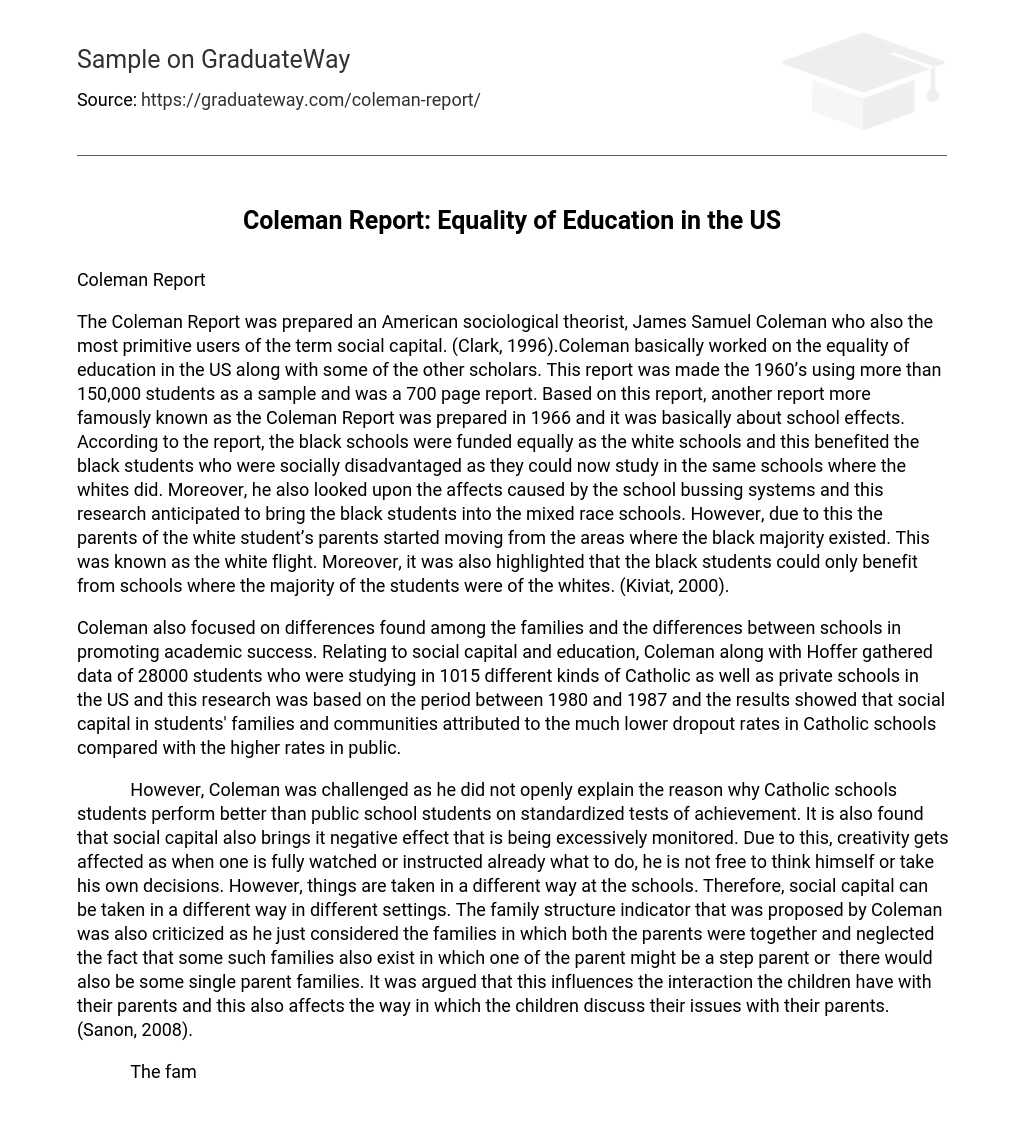Coleman Report
The Coleman Report was prepared an American sociological theorist, James Samuel Coleman who also the most primitive users of the term social capital. (Clark, 1996).Coleman basically worked on the equality of education in the US along with some of the other scholars. This report was made the 1960’s using more than 150,000 students as a sample and was a 700 page report. Based on this report, another report more famously known as the Coleman Report was prepared in 1966 and it was basically about school effects. According to the report, the black schools were funded equally as the white schools and this benefited the black students who were socially disadvantaged as they could now study in the same schools where the whites did. Moreover, he also looked upon the affects caused by the school bussing systems and this research anticipated to bring the black students into the mixed race schools. However, due to this the parents of the white student’s parents started moving from the areas where the black majority existed. This was known as the white flight. Moreover, it was also highlighted that the black students could only benefit from schools where the majority of the students were of the whites. (Kiviat, 2000).
Coleman also focused on differences found among the families and the differences between schools in promoting academic success. Relating to social capital and education, Coleman along with Hoffer gathered data of 28000 students who were studying in 1015 different kinds of Catholic as well as private schools in the US and this research was based on the period between 1980 and 1987 and the results showed that social capital in students’ families and communities attributed to the much lower dropout rates in Catholic schools compared with the higher rates in public.
However, Coleman was challenged as he did not openly explain the reason why Catholic schools students perform better than public school students on standardized tests of achievement. It is also found that social capital also brings it negative effect that is being excessively monitored. Due to this, creativity gets affected as when one is fully watched or instructed already what to do, he is not free to think himself or take his own decisions. However, things are taken in a different way at the schools. Therefore, social capital can be taken in a different way in different settings. The family structure indicator that was proposed by Coleman was also criticized as he just considered the families in which both the parents were together and neglected the fact that some such families also exist in which one of the parent might be a step parent or there would also be some single parent families. It was argued that this influences the interaction the children have with their parents and this also affects the way in which the children discuss their issues with their parents. (Sanon, 2008).
The families that maintain their traditional values also make it easier for the immigrants to mix up socially as well as to maintain camaraderie in an ethnic community. This also helps the children to achieve success in their academics as maintaining the literacy in native language serves as a form of social capital that further contributes to academic achievement in a positive way. Social capital plays a major role in the development of a child and results in many positive outcomes especially in education. (Putnam, 2001).This is because the families in which the social capital is found to be high, the education level in such families is also high. Similarly the more the parents are concerned about the education of their child, the higher is the performance of the child. Furthermore, such children also have lesser tendencies to misbehave at school or being indifferent to education.
References
Clark,J. (1996).James S. Coleman. Consensus and Controversy. Falmer Sociology Series. 1st Edn. Routledge,Paperback.
Kiviat,B.J. (2000). The Social Side of Schooling. October 5, 2008. Retrieved from: http://www.jhu.edu/~jhumag/0400web/18.html
Sanon,L.(2008).The Effects of Parental Level of Education – Social Capital among African- American College Students. VDM Verlag Dr. Mueller e.K., Paperback.
Putnam,R.D. (2001). Bowling Alone: The Collapse and Revival of American Community. 1st Edn. Simon & Schuster,Paperback.





